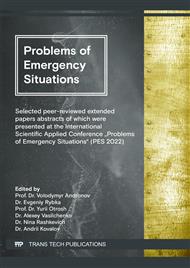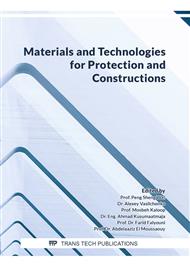[1]
B. Pospelov et al., Studying the recurrent diagrams of carbon monoxide concentration at early ignitions in premises. Eastern-European Journal of Enterprise Technologies, 3/9 (93) (2018) 34–40.
DOI: 10.15587/1729-4061.2018.133127
Google Scholar
[2]
B. Pospelov et al., Development of the method of operational forecasting of fire in the premises of objects under real conditions. Eastern-European Journal of Enterprise, 2/10 (110) (2021) 43–50.
DOI: 10.15587/1729-4061.2021.226692
Google Scholar
[3]
B. Pospelov, V. Andronov, E. Rybka, V. Popov, A. Romin, Experimental study of the fluctuations of gas medium parameters as early signs of fire. Eastern-European Journal of Enterprise Technologies, 1 10 91 (2018) 50–55.
DOI: 10.15587/1729-4061.2018.122419
Google Scholar
[4]
B. Pospelov, V. Andronov, E. Rybka, S. Skliarov, Design of fire detectors capable of self-adjusting by ignition. Eastern-European Journal of Enterprise Technologies, 4 9 88 (2017) 53–59.
DOI: 10.15587/1729-4061.2017.108448
Google Scholar
[5]
V. Andronov, B. Pospelov, E. Rybka, S. Skliarov, Examining the learning fire detectors under real conditions of application. Eastern-European Journal of Enterprise Technologies, 3 9 87 (2017) 53–59.
DOI: 10.15587/1729-4061.2017.101985
Google Scholar
[6]
D. Dubinin et al., Investigation of the effect of carbon monoxide on people in case of fire in a building | Ispitivanje djelovanja ugljičnog monoksida na ljude u slučaju požara u zgradi. Sigurnost, 62 (4) (2020) 347– 357.
DOI: 10.31306/s.62.4.2
Google Scholar
[7]
B. Pospelov et al., Results of experimental research into correlations between hazardous factors of ignition of materials in premises. Eastern-European Journal of Enterprise Technologies, 6/10 (90) (2017) 50–56.
DOI: 10.15587/1729-4061.2017.117789
Google Scholar
[8]
B. Pospelov et al., Analysis of correlation dimensionality of the state of a gas medium at early ignition of materials. Eastern-European Journal of Enterprise Technologies, 5/10 (95) (2018) 25–30.
DOI: 10.15587/1729-4061.2018.142995
Google Scholar
[9]
Teslenko A., Chernukha A., Bezuglov O., Bogatov O., Kunitsa E., Kalyna V., Katunin A., Kobzin V., Minka S. Construction of an algorithm for building regions of questionable decisions for devices containing gases in a linear multidimensional space of hazardous factors. Eastern-European Journal of Enterprise Technologies, 5 (10–101) (2019) 42–49.
DOI: 10.15587/1729-4061.2019.181668
Google Scholar
[10]
M. Kustov, V. Kalugin, V. Tutunik, E. Tarakhno, Physicochemical principles of the technology of modified pyrotechnic compositions to reduce the chemical pollution of the atmosphere. Voprosy khimii i khimicheskoi tekhnologii, 1 (2019) 92–99.
DOI: 10.32434/0321-4095-2019-122-1-92-99
Google Scholar
[11]
Y. Danchenko et al., Research into surface properties of disperse fillers based on plant raw materials. Eastern-European Journal of Enterprise Technologies, 5/12 (89) (2017) 20–26.
DOI: 10.15587/1729-4061.2017.111350
Google Scholar
[12]
B. Pospelov et al., Short-term forecast of fire in the premises based on modification of the Brown's zero-order model. Eastern-European Journal of Enterprise Technologies, 4/10 (112) (2021) 52–58.
DOI: 10.15587/1729-4061.2021.238555
Google Scholar
[13]
NFPA 921. Guide for Fire and Explosion Investigations. Massachusetts, 2017 [USA].
Google Scholar
[14]
Forside - Det Digitale Projektbibliotek, Aalborg Universitet. URL: https://projekter.aau.dk/projekter/files/280751049/MSco4ID6___Master_thesis.pdf.
Google Scholar
[15]
S. I. Padalko, M. S. Karpenko, Issledovanie jekologicheskih aspektov ispol'zovanija al'ternativnogo topliva. Sbornik nauchnyh trudov DonNASA, 1 (2017) 23–30.
Google Scholar
[16]
Pospelov B., Meleshchenko R., Krainiukov O., Karpets K., Petukhova O., Bezuhla Y., Butenko T., Horinova V., Borodych P., Kochanov E. A method for preventing the emergency resulting from fires in the premises through operative control over a gas medium. Eastern-European Journal of Enterprise Technologies, 10–103 (2020) 6–13.
DOI: 10.15587/1729-4061.2020.194009
Google Scholar
[17]
W. Kalkreuth et al., Optical and chemical characterization of solid residues obtained from vacuum pyrolysis of wood (aspen poplar). Biomass, 10 (1986) 27–45.
DOI: 10.1016/0144-4565(86)90034-x
Google Scholar
[18]
V. A. Stolyarova et al., Novyi spravochnik khimika i tekhnologa. Syr'e i produkty promyshlennosti organicheskikh i neorganicheskikh veshchestv. NPO «Professional», 2 (2002).
Google Scholar
[19]
H. Biteau et al., Ability of the Fire Propagation Apparatus to characterise the heat release rate of energetic materials. Journal of Hazardous Materials, 166 (2-3) (2009) 916-924.
DOI: 10.1016/j.jhazmat.2008.11.100
Google Scholar
[20]
D.K. Shen et al., Analysis of wood structural changes under thermal radiation. Energy Fuels, 23 (2) (2009) 1081–1088.
Google Scholar
[21]
Y. Yang et al., Mathematical modelling of slow pyrolysis of segregated solid wastes in a packed-bed pyrolyser. Fuel, 86 (2007) 169–180.
DOI: 10.1016/j.fuel.2006.07.012
Google Scholar
[22]
L. Shi, M. Chew, A review of fire processes modeling of combustible materials under external heat flux. Fuel, 106 (2013) 30–50.
DOI: 10.1016/j.fuel.2012.12.057
Google Scholar
[23]
F. Richter, G. Rein, A multiscale model of wood pyrolysis in fire to study the roles of chemistry and heat transfer at the mesoscale. Combustion and Flame, 216 (2020) 316–325.
DOI: 10.1016/j.combustflame.2020.02.029
Google Scholar
[24]
F. Jia et al., The numerical simulation of the noncharring pyrolysis process and fire development within a compartment. Applied Mathematical Modelling, 23 (8) (1999) 587–607.
DOI: 10.1016/s0307-904x(99)00003-7
Google Scholar
[25]
L. Shi et al., An experimental and numerical study on fire behaviors of charring materials frequently used in buildings. Energy and Buildings, 138 (2017). 140–153.
DOI: 10.1016/j.enbuild.2016.12.035
Google Scholar
[26]
D. Dubinin et al. Eksperymental'ne doslidzhennja rozvytku pozhezhi v budivli. Scientific Journal Problems of Emergency Situations, 34 (2022) 110–121.
Google Scholar
[27]
D. Dubinin et al., Improving the installation for fire extinguishing with finely-dispersed water. Eastern-European Journal of Enterprise Technologies, 2/10 (92) (2018) 38–43.
DOI: 10.15587/1729-4061.2018.127865
Google Scholar
[28]
A. Semko A. et al., The use of pulsed high-speed liquid jet for putting out gas blow-out. The International Journal of Multiphysics, 9 (1) (2015) 9–20.
DOI: 10.1260/1750-9548.9.1.9
Google Scholar
[29]
K. Korytchenko et al., Enhancing the fire resistance of concrete structures by applying fire retardant temperature-resistant metal coatings. Materials Science Forum, 1038 (2021) 500–505.
DOI: 10.4028/www.scientific.net/msf.1038.500
Google Scholar
[30]
A. Kasimov et al., Numerical study of the process of compressing a turbulized two-temperature air charge in the diesel engine. Eastern-European Journal of Enterprise Technologies, 6/5 (96), (2018) 49– 53.
DOI: 10.15587/1729-4061.2018.150376
Google Scholar
[31]
K. Korytchenko et al., Experimental investigation of the fire-extinguishing system with a gas-detonation charge for fluid acceleration. Eastern-European Journal of Enterprise Technologies, 3/5 (93) (2018) 47– 54.
Google Scholar
[32]
K. Korytchenko et al., Numerical simulation of influence of the non-equilibrium excitation of molecules on direct detonation initiation by spark discharge. Problems of Atomic Science and Technology, 116 (4) (2018) 194–199.
Google Scholar
[33]
K. Korytchenko et al., Numerical simulation of initial pressure effect on energy input in spark discharge in nitrogen. Problems of Atomic Science and Technology, 122 (4) (2019) 116–119.
DOI: 10.46813/2019-122-116
Google Scholar



